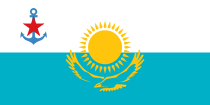Flag of Kazakhstan
 | |
| Name |
Қазақстан Республикасының мемлекеттік туы Qazaqstan Respýblıkasynyń memlekettik týy |
|---|---|
| Use | National flag and civil ensign |
| Proportion | 1:2 |
| Adopted | 4 June 1992 |
| Design | A gold sun with 32 rays above a soaring golden steppe eagle, both centered on a sky blue field. The hoist side displays a national ornamental pattern "koshkar-muiz" (the horns of the ram) in gold |
| Designed by | Shaken Niyazbekov |
 Variant flag of Kazakhstan | |
| Use | State ensign |
| Proportion | 1:2 |
 Variant flag of Kazakhstan | |
| Use | Naval ensign |
| Proportion | 1:2 |
The current flag of Kazakhstan or Kazakh flag (Kazakh: Қазақстан туы, Qazaqstan týy) was adopted on 4 June 1992, replacing the flag of the Kazakh Soviet Socialist Republic. The flag was designed by Shaken Niyazbekov. The color choices had preserved the blue and gold from the Soviet era flag minus the red.
Description
The national flag of the Republic of Kazakhstan has a gold sun with 32 rays above a soaring golden steppe eagle, both centered on a sky blue background; the hoist side displays a national ornamental pattern "koshkar-muiz" (the horns of the ram) in gold; the blue color is of religious significance to the Turkic peoples of the country, and so symbolizes cultural and ethnic unity; it also represents the endless sky as well as water; the sun, a source of life and energy, exemplifies wealth and plenitude; the sun's rays are shaped like grain, which is the basis of abundance and prosperity; the eagle has appeared on the flags of Kazakh tribes for centuries and represents freedom, power, and the flight to the future. The width of the flag to its length is 1:2.[1]
Interpretation
The gold and blue colors were inherited from the former Soviet flag which were the gold from the hammer and sickle and the cyan bar from the bottom of the flag. The pattern represents the art and cultural traditions of the old khanate and the Kazakh people. The sky blue background symbolizes the peace, freedom, cultural, and ethnic unity of Kazakh people including the various Turkic peoples that make up the present-day population such as the Kazakhs, Tatars, Uyghurs, Uzbeks, as well as the significant Mongol and Russian peoples. The sun represents a source of life and energy. It is also a symbol of wealth and abundance; the sun's rays are a symbol of the steppe's grain which is the basis of abundance and prosperity.
People of different Kazakh tribes had the golden eagle on their flags for centuries. The eagle symbolizes the power of the state. For the modern nation of Kazakhstan the eagle is a symbol of independence, freedom and flight to the future.[2]
Historical flags
 Alleged flag of the Kazakh Khanate
Alleged flag of the Kazakh Khanate Flag of the Alash Autonomy
Flag of the Alash Autonomy.svg.png) Flag of the Kazakh Soviet Socialist Republic from 1937—1940
Flag of the Kazakh Soviet Socialist Republic from 1937—1940.svg.png) Flag of the Kazakh Soviet Socialist Republic from 1940—1953
Flag of the Kazakh Soviet Socialist Republic from 1940—1953 Flag of the Kazakh Soviet Socialist Republic from 1953—1991 and the independent Kazakhstan from 1991—1992
Flag of the Kazakh Soviet Socialist Republic from 1953—1991 and the independent Kazakhstan from 1991—1992.svg.png) Early design of the flag of the Republic of Kazakhstan before June 4, 1992.[3]
Early design of the flag of the Republic of Kazakhstan before June 4, 1992.[3]
See also
References
- ↑ CIA – The World Fact Book Archived 9 August 2010 at the Wayback Machine.
- ↑ Kazakhstan national flag
- ↑ "государственный флаг Казахстана". www.vexillographia.ru. Retrieved 2018-10-09.
External links
| Wikimedia Commons has media related to Flags of Kazakhstan. |

